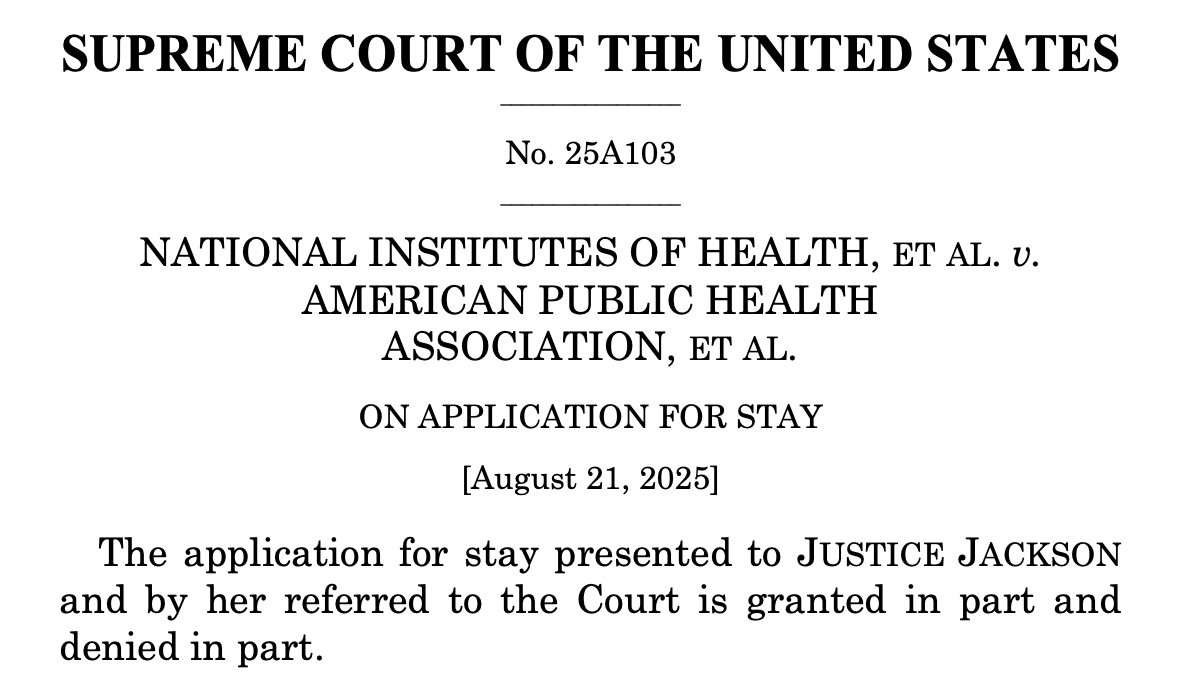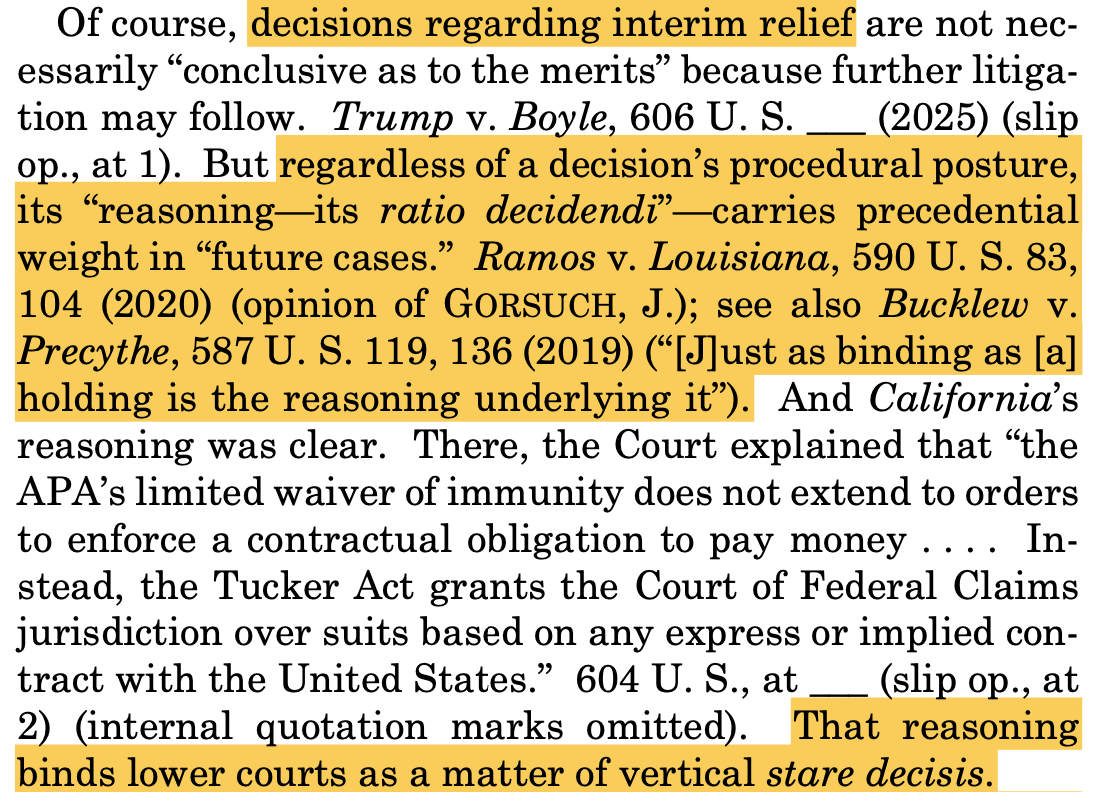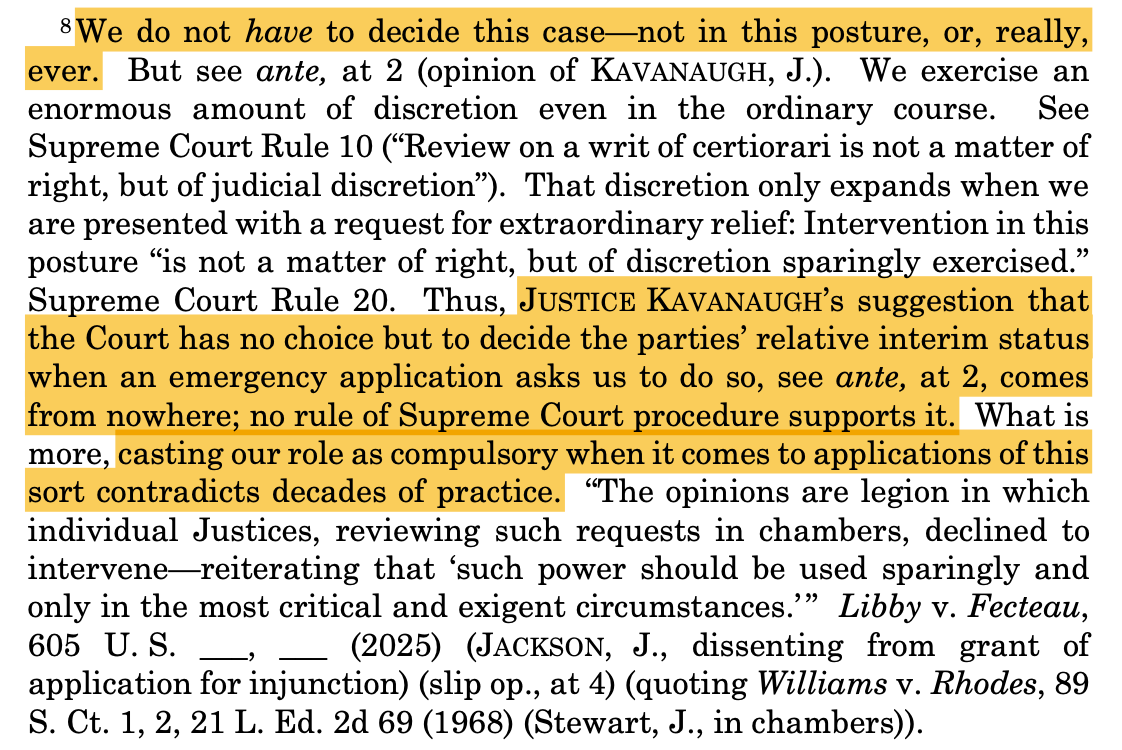Trump's SCOTUS appointees each shared alarming views in allowing NIH grant cuts
Justices Gorsuch, Kavanaugh, and Barrett each wrote something in the shadow docket case — disturbing opinions in light of broader attacks on the rule of law.
President Donald Trump’s three appointees to the U.S. Supreme Court each made alarming statements in a single case about federal health research grants last week, particularly when viewed in light of the broader attack on the rule of law in America.
Taken together, their statements in an order on the shadow docket on a Thursday afternoon in August show how understanding the Supreme Court is going to be — and must be — a fundamentally different undertaking from learning law for the near-term future.
That has certainly been illustrated repeatedly over the nearly five years since Justice Amy Coney Barrett took her seat on the bench. But, the August 21 order in a pair of cases challenging the legality of National Institutes of Health guidance that led to the cancellation of research grants across the nation — an order that hinged on Barrett’s vote — really nailed down just how Trump’s appointees are backing the Trump administration in its attacks on the rule of law.
Affecting “hundreds of millions of dollars [in grants] allocated to support life-saving biomedical research“ that were canceled by the NIH in an effort purporting to implement Trump’s anti-”DEI” and anti-transgender executive orders, as Justice Ketanji Brown Jackson explained in partial dissent, the underlying issues in the case are complicated but important, so let me explain.
In the Supreme Court’s order on August 21, the majority partially stayed the district court’s order — a stay of which was denied by the appeals court — as to its decision “vacating the Government’s termination of various research-related grants.”
Although technical, how we got there and what it means matters. As Jackson wrote, “For a cautionary tale about lawmaking on the emergency docket, look no further than this newest iteration.”
Let’s dig in.
What does this mean?
The district court had ordered the grant cancelations to be vacated — the grants to be put back in place — because the guidance and grant cancellations that followed violated the Administrative Procedure Act. To implement its ruling, the district court vacated both the guidance and grant cancellations.
The Supreme Court, in four unsigned paragraphs, said no — the Trump administration could keep the grants canceled during this litigation. The court cited an earlier shadow docket ruling in which a five-justice majority held that a challenge to mass-canceled Education Department grants was likely the type of lawsuit seeking a court order “to enforce a contractual obligation to pay money” that is required to be heard before a specialty court, the Court of Federal Claims, under the Tucker Act. In the August 21 order, the court held that the district court order restoring the NIH grants was to be blocked for similar reasons.
At the same time, the Supreme Court did not stay the district court’s order vacating the underlying NIH guidance itself. That guidance, again, was purporting to implement Trump’s executive orders targeting diversity, equity, inclusion, and accessibility programs and “gender ideology” programs.
What this meant, in effect, is that the targeted NIH grants are and will remain canceled for the time being — potentially for years, if not forever — despite the guidance itself likely violating the APA.
What’s more, the actual ruling was a mess. Two different five-justice majorities made up each part of the ruling, with Barrett being the only justice who agreed with it all.
Jackson’s disagreement with the five-justice majority allowing the grants to be canceled during litigation got headlines on Friday for its succinct explanation of the current court.
“This is Calvinball jurisprudence with a twist,” she wrote. “Calvinball has only one rule: There are no fixed rules. We seem to have two: that one, and this Administration always wins.”
Jackson is right. As she put it in more legal — and consequential — terms later, “The approach the Court adopts today (which, again, no party advocated for) neither coheres legally nor operates practically. So, unfortunately, this newest entry in the Court’s quest to make way for the Executive Branch has real consequences, for the law and for the public.“
Although Jackson wrote only for herself, Chief Justice John Roberts wrote a one-paragraph opinion explaining for himself, Jackson, and Justices Sonia Sotomayor and Elena Kagan that the issues here were distinguishable from the earlier shadow docket ruling. This is a sensible statement — as illustrated most clearly by the fact that, of the 13 judges to have issued orders on the question, eight of them agreed the NIH case was distinguishable from the Education case.
Justices Clarence Thomas, Sam Alito, Neil Gorsuch, and Brett Kavanaugh, in contrast, would have granted the Trump administration’s request in full and blocked the entire district court order — including the ruling on the NIH guidance — during appeals. This is itself a shocking position, all the more because four justices of the Supreme Court took it. Thomas and Alito wrote nothing beyond announcing their vote, but both Gorsuch and Kavanaugh wrote opinions.
As described above, however, the court did what neither of those four-justice groupings wanted. Instead, based on the vote of Barrett, the court stayed the part of the district court’s order restoring the grants and kept the part of the order vacating the NIH guidance in effect during appeals. The two different sets of four justices provided the other votes to make each portion of Barrett’s vote a majority — even though each set applied significantly different reasoning from Barrett to reach that vote.
That’s the case and the order, but I want to look at the opinions of the Trump appointees — all of whom agreed the Trump administration should be able to keep the grants canceled during the APA litigation.
What did the Trump appointees tell us?
Barrett is going further down her path of making law on the fly, pretending the problems inherent in such an approach don’t exist.
This was most clearly seen in her opinion in the “universal injunctions” ruling, which was brought on the shadow docket, considered on an abbreviated schedule, left key questions unanswered, and created many new problems. And that was a situation where the justices at least held oral arguments on the issue before ruling.
Here, though, there were no oral arguments. There was no full briefing and little time for outside non-parties to the litigation to weigh in about the consequences of any ruling here. While major cases sometimes lead to dozens and dozens of amicus curiae — friend of the court — briefs, this shadow docket order was preceded only by two such filings.
Nonetheless, Barrett waded into the matter on the shadow docket and crafted a decision that, as Jackson noted, neither party recommended. Now, to be sure, that alone doesn’t make a ruling wrong. Parties often are going to argue only their preferred position. Sometimes they propose alternatives if the court doesn’t agree with their preferred outcome, but that didn’t happen here. In such a situation, the court should — and generally would — be especially cautious about taking that path, not just because of the result before the court but because of the consequences of the decision in other cases.
Barrett, in her opinion concurring in the order, simply announced that “two-track litigation” is fine here because it “results from ‘[t]he jurisdictional scheme governing actions against the United States’“ like these cases. “And if the [Court of Federal Claims] has exclusive jurisdiction over the grant terminations,” Barrett wrote, citing only to the earlier shadow docket ruling, “the plaintiffs cannot end-run that limit simply by packaging them with a challenge to agency guidance.”
This is where the wheels fell off the wagon, doubly so.
First, substantively. As Jackson explained in her partial dissent, this could bar plaintiffs from receiving the very “complete relief” that Barrett clung to as a possibility in the injunctions case. Because the Court of Federal Claims can’t issue injunctive or declaratory relief — it can only order money damages — the court’s order last week could bar any court from putting the grants themselves back in place, even if the guidance that allowed for the grant cancellation is declared to be illegal.
Second, procedurally. The “if” in Barrett’s statement is key. This is the fundamental problem with what Barrett is doing here. This is simply supposed to be an initial, first-look order that is setting the status of things for the parties pending appeals court consideration and possible Supreme Court consideration of the case. Lest there be any doubt about that, Barrett reiterated it in her conclusion: “[M]y preliminary judgment is that the plaintiffs’ challenges to the grant terminations belong in the CFC, and their APA challenges to the guidance belong in district court.” Her “preliminary judgment.”
This would be bad enough if that were all that it was — this case: The money and programs and research, which Jackson detailed at length, that will be cut. But, it’s not.
Enter Gorsuch.
Gorsuch harshly reprimanded lower courts for not applying the court’s orders in shadow docket applications properly to other cases, warning of “anarchy” with sloppy writing and worse reasoning.
“Lower court judges may sometimes disagree with this Court’s decisions, but they are never free to defy them,“ Gorsuch, joined by Kavanaugh, began. After writing what he believed the Education Department shadow docket opinion “explained,” he moved on to his target: “Rather than follow that direction, the district court in this case permitted a suit involving materially identical grants to proceed to final judgment under the APA.”
Gorsuch’s opinion being bad — which it is — would be alarming enough. It’s also wrong.
Remember that, for four justices, Roberts wrote that, in his view, the vacated guidance in this case “distinguishes” it from the Education grants case. For Gorsuch, though, his four colleagues and the four judges below the Supreme Court who disagree with him about whether the NIH case can be distinguished from the Education case are either irrelevant or anarchists.
“[U]nless we wish anarchy to prevail within the federal judicial system, a precedent of this Court must be followed by the lower federal courts no matter how misguided the judges of those courts may think it to be,” Gorsuch wrote, quoting from a case that had followed in the aftermath of a Supreme Court decision in a fully considered merits case ruling.
Even in the context of a shadow docket order addressing an earlier shadow docket order (“turtles all the way down”), Gorsuch continued his reprimand — for himself and Kavanaugh — by stating that “when this Court issues a decision, it constitutes a precedent that commands respect in lower courts.“
Contrast that with what Barrett wrote, where she noted that this was her “preliminary judgment” about this case — and even that is only based on the premise of the earlier order, “if” that preliminary opinion in the Education case is correct.
Through his temper tantrum, Gorsuch goes a long way toward proving why the shadow docket’s orders — and the associated bare-bones, unsigned explanation when any is given — are exceptionally poor tools for lower courts to use as “precedent.”
After warning of the “anarchy” from below should lower courts not apply shadow docket “precedent” from such orders as Gorsuch believes it exists, he actually went on to show how meaningless his protestation is. This is how he backed up (backs off from?) his “precedent” claim in the next paragraph:
Once you actually get through Gorsuch’s bluster and back-tracking, where we are left is the secondary, next point he makes — which is unobjectionable and about which virtually everyone agrees: The “probabilistic holdings“ of shadow docket applications for stays or injunctions pending appeal “must ‘inform how a [lower] court’ proceeds ‘in like cases.’”
And yet, last week Gorsuch felt it necessary to accuse lower court judges of “anarchy” because they (along with four of his colleagues at the Supreme Court) disagreed about whether the NIH case was actually a “like” case to the Education Department case.
Finally, there’s Kavanaugh.
Kavanaugh simply changed Supreme Court rules — without so much as a nod to the fact that he was doing so.
Addressing Jackson’s partial dissent, he wrote that she “seems to suggest that we can avoid this significant (albeit interim) forum-channeling decision” — about whether this case can proceed in the district court — “by simply denying the application. That is wrong.”
Thinking he was clever, Kavanaugh then wrote, “We have to decide the application.”
Obviously, yes, the court has to rule on the application. But, as Jackson actually explained — it’s notable that Kavanaugh did not quote her, instead choosing to (mis)characterize her writing — she wrote that the court “ought to ensure that the applicant faces the sort of true emergency that warrants our consideration of its request … — what I have elsewhere called a ‘line-jumping justification.’“
Given how Kavanaugh addressed that, Jackson dropped an appropriately aggressive footnote explaining why he was wrong:
Kavanaugh’s claim “comes from nowhere; no rule of Supreme Court procedure supports it.”
Making law on the fly with little to no outside input, accusing those who disagree with you of anarchy, and changing the rules without even saying that is what’s happening — sounds like Trump appointees to me.







Excellent coverage of a pretzel writing.
Gorsuch is a petty little bitch. And Kavanaugh really isn't a great legal mind...he only plays one after a few beers. And Barrett...I've given up understanding her.
Best thing Biden did? Appoint Justice Jackson.
The bottom line is that the six MAGgots on the "Supreme" court are nothing more than a cacophony of yes people to our dear leader (see George Orwell for more details).
The convolution of the different arguments are difficult to untangle for a lay person like myself.
Thanks for writing all of that, however.